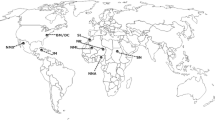Abstract
Soil bacteria are sensitive to ecological change and can be assessed to gauge anthropogenic influences and ecosystem health. In recent years, there has been a significant increase in the focus on new technologies that can be applied to the evaluation of soil quality. Laser-induced breakdown spectroscopy (LIBS) is a promising technique that has been used for the investigation and characterization of explosives, solids, liquids, gases, biological and environmental samples. In this study, bacteria from un-mined and a chronosequence of reclaimed bauxite soils were isolated on Luria–Bertani agar media. Polymerase chain reaction amplification of the bacterial 16S rDNA, sequencing, and phylogenetic analysis were applied to each isolated soil bacteria from the sample sites resulting in the identification and classification of the organisms. Femtosecond LIBS performed on the isolated bacteria showed atomic and ionic emission lines in the spectrum containing inorganic elements such as sodium (Na), magnesium (Mg), potassium (K), zinc (Zn), and calcium (Ca). Principal component analysis and partial least squares regression analysis were performed on the acquired bacterial spectra demonstrating that LIBS has the potential to differentiate and discriminate among bacteria in the un-mined and reclaimed chronosequence of bauxite soils.








Similar content being viewed by others
References
Dworzanski JP, Snyder AP, Chen R, Zang H, Wishart D, Li L (2004) Identification of bacteria using tandem mass spectrometry combined with a proteome database and statistical scoring. Anal Chem 76:2355–2366
van Elsas JD, Boersma FGH (2011) A review of molecular methods to study the microbiota of soil and the mycosphere. Eur J Soil Biol 47:77–87
Schmidt NE, Goode SR (2002) Analysis of aqueous solutions by laser-induced breakdown spectroscopy of ion exchange membranes. Appl Spectrosc 56:370–374
Morel S, Leon N, Adam P, Amouroux J (2003) Detection of bacteria by time-resolved laser-induced breakdown spectroscopy. Appl Opt 42:6184–6191
Martin MZ, Cheng MD (2000) Detection of chromium aerosol using time-resolved laser-induced plasma spectroscopy. Appl Spectrosc 54:1279–1285
Galiová M, Kaiser J, Novotný K, Samek O, Reale L, Malina R, Páleníková K, Liška M, Čudek V, Kanický V, Otruba V, Poma A, Tucci A (2007) Spectrochimica Acta Part B 62:1597–1605
Multari R, Cremers DA, Dupre JM, Gustafson JE (2010) The use of laser-induced breakdown spectroscopy for distinguishing between bacterial pathogen species and strains. Appl Spectrosc 64:750–759
Rehse SJ, Diedrich J, Palchaudhuri S (2007) Identification and discrimination of Pseudomonas aeruginosa bacteria grown in blood and bile by laser-induced breakdown spectroscopy. Spectrochimica Acta Part B 62:1169–1176
Rehse SJ, Jeyasingham N, Diedrich J, Palchaudhuri S (2009) A membrane basis for bacterial identification and discrimination using laser-induced breakdown spectroscopy J. Appl Phys 105:102034-1-13
Barnett C, Bell C, Komal Vig AC, Akpovo LJ, Pillai S, Singh S (2011) Development of a LIBS assay for the detection of Salmonella enterica serovar typhimurium from food. Anal Bioanal Chem 400(10):3323–3330
Samek O, Beddows DCS, Telle HH, Morris GW, Liska M, Kaiser J (1999) Quantitative analysis of trace metal accumulation in teeth using laser-induced breakdown spectroscopy. Appl Phys A 69:S179–S182
Samek O, Liška M, Kaiser J, Beddows DCS, Telle HH, Kukhlevsky SV (2000) J Clin Laser Med Surg 18:281
Samuels AC, De Lucia FC Jr, McNesby KL, Miziolek AW (2003) Laser-induced breakdown spectroscopy of bacterial spores, molds, pollens and protein: initial studies of discrimination potential. Appl Opt 42:6205–6209
M Baudelet, L Guyon, J Yu, J-P Wolf, T Amodeo, E Frejafon, P Laloi (2006) Spectral signature of native CN bonds for bacterium detection and identification using femtosecond laser-induced breakdown spectroscopy. Appl. Phys. Lett. 88(063901-1-3)
M Baudelet, L Guyon, J Yu, J-P Wolf, T Amodeo, E Frejafon, P Laloi (2006) Femtosecond time-resolved laser-induced breakdown spectroscopy for detection and identification of bacteria: a comparison to the nanosecond regime, J. Appl. Phys. 99(084701-4-9)
Lewis DE, White JR, Wafula D, Athar R, Williams HN, Chauhan A (2010) Soil functional diversity analysis of a bauxite mined restoration chronosequence. Microb Ecol 59:710–723
Scholten JJ, Andriesse W (1986) Morphology, genesis and classification of three soils over limestone, Jamaica. Geoderma 39:1–40
Muyzer G, De Waal C, Uitterlinden AG (1993) Profiling of complex microbial populations by denaturing gradient gel electrophoresis analysis of polymerase chain reaction-amplified genes coding for 16S rRNA. Appl Environ Microbiol 59:695–700
Wojdyr M (2010) Fityk: a general-purpose peak fitting program. J Appl Cryst 43:1126–1128
Rosipal R, Krämer N (2006) Overview and Recent Advances in Partial Least Squares. In C. Saunders, M. Grobelnik, S. Gunn, & J. Shawe-Taylor (Eds.), Subspace, Latent Structure and Feature Selection Techniques. Springer
Martin MZ, Labbe’ N, Rials TG, Wullschleger SD (2005) Analysis of preservative-treated wood by multivariate analysis of laser-induced breakdown spectroscopy spectra. Spectrochimica Acta Part B 60:1179–1185
Heaton HI (2005) Principal-components analysis of fluorescence cross-section spectra from pathogenic and simulant bacteria. Appl Opt 44:6486–6495
Wold S, Sjöstöm M, Erikkson L (2001) PLS-regression: a basic tool of chemometrics. Chemometr Intell Lab Syst 58:109–130
Rials TG, Kelley SS, So C-L (2002) Use of advanced spectroscopic techniques for predicting the mechanical properties of wood composites. Wood Fiber Sci 34:398–407
Barker M, Rayens W (2003) Partial least squares for discrimination. J Chemometr 17:166–173
Ciosek P, Brzózka Z, Wróblewski W, Martinelli E, Di Natale C, D’Amico A (2005) Direct and two stage data analysis procedures based on PCA, PLS-DA and ANN for ISE-based electronic tongue—effect of supervised feature extraction. Talanta 67:590–596
Singleton P (1997) Bacteria in biology, biotechnology and medicine, 4th edn. Wiley, Chichester
Beebe K, Pell R, Seasholtz MB (1998) Chemometrics: a practical guide, 1st edn. Wiley-Interscience, New York
Acknowledgment
The authors gratefully acknowledge the financial support provided by JAMALCO/ALCOA.
Author information
Authors and Affiliations
Corresponding author
Rights and permissions
About this article
Cite this article
Lewis, D.E., Martinez, J., Akpovo, C.A. et al. Discrimination of bacteria from Jamaican bauxite soils using laser-induced breakdown spectroscopy. Anal Bioanal Chem 401, 2225–2236 (2011). https://doi.org/10.1007/s00216-011-5274-y
Received:
Revised:
Accepted:
Published:
Issue Date:
DOI: https://doi.org/10.1007/s00216-011-5274-y




